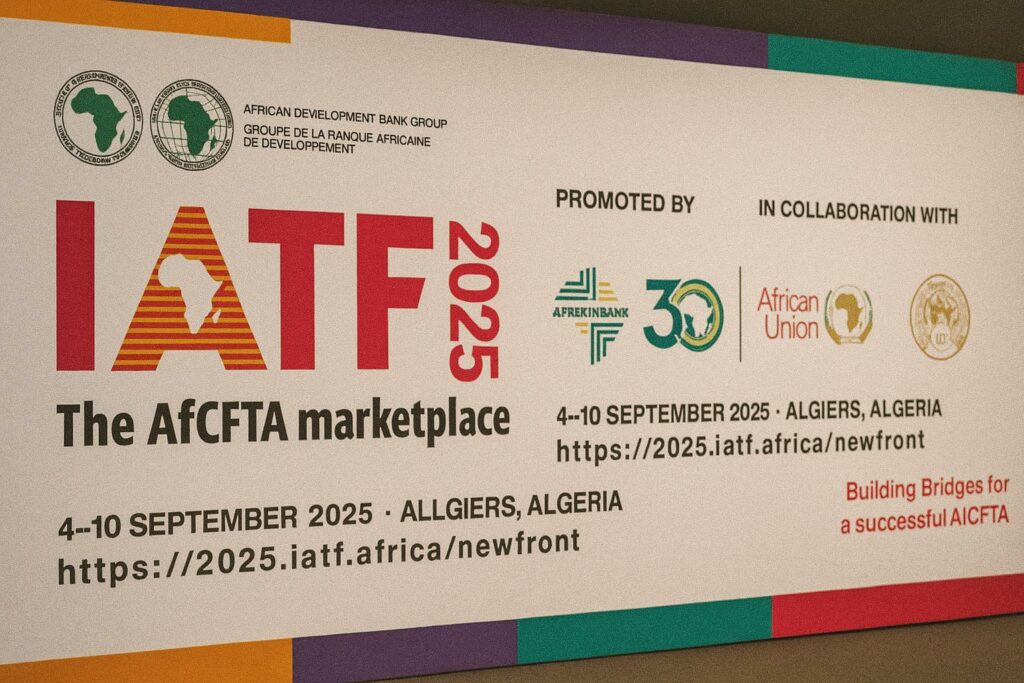Algiers Sets the Stage for Pan-African Commerce
From 4 to 10 September, the Palais des Expositions in Algiers will momentarily become the continent’s busiest trading floor. The fourth Intra-African Trade Fair (IATF), convened by Afreximbank in partnership with the African Union and the African Continental Free Trade Area Secretariat, is forecast to welcome more than 2 000 companies, 35 000 visitors and a cohort of political leaders intent on translating the AfCFTA’s promise into palpable contracts (Afreximbank press release). The organisers target 44 billion USD in trade and investment commitments—an ambition that would eclipse the 36 billion concluded during the Durban edition of 2021.
Algeria’s selection as host is symbolically resonant. The North African economy, long anchored in hydrocarbons, has been vocal about recalibrating its external relationships toward Africa. By providing the logistical canvas for the fair, Algiers underscores its aspiration to serve as a Mediterranean gateway to the AfCFTA market of 1.4 billion people and a combined GDP nearing 3.4 trillion USD (UNECA data).
AfCFTA Objectives and the High 5 Nexus
The fair’s theme, “Building Bridges for a Successful AfCFTA”, dovetails neatly with two pillars of the African Development Bank’s High 5 agenda—“Industrialise Africa” and “Integrate Africa”. The Bank, a member of the IATF advisory council, will run a dedicated pavilion where dealmakers may pitch projects spanning infrastructure, agribusiness, creative industries and digital services. In effect, the IATF operates as a microcosm of the continental free-trade project: tariffs are removed from the conversation, and attention shifts to the equally arduous tasks of securing finance, harmonising standards and identifying complementary value chains.
For AfCFTA Secretary-General Wamkele Mene, quoted during the pre-event briefing in Cairo, the Algiers fair represents “the most visible conveyor belt between political commitment and factory-floor reality”. His remark captures the essence of the gathering: the agreement’s rules are in place; the next hurdle is to stimulate firm-level confidence that new regional demand truly exists.
A Window of Opportunity for Congo-Brazzaville
Congo-Brazzaville’s export ledger, still dominated by crude oil and timber, stands to gain from the fair’s sectoral breadth. Officials from Brazzaville’s Ministry of Industrial Development have confirmed the dispatch of a multi-sector delegation comprising agri-food processors, wood-transformation enterprises and fintech start-ups. The Port Autonome de Pointe-Noire, increasingly marketed as a multimodal hub for Central Africa, also plans to showcase logistics packages tailored to hinterland economies such as the Central African Republic and the two Kivus of the DRC.
By leveraging the AfCFTA’s preferential rules of origin, Congolese agro-processors eye West African markets for cacao-based confectionery sourced from Sangha plantations, while manufacturers of plywood in Ouesso hope to lock supply agreements with Egyptian and Moroccan furniture clusters. In parallel, the Société Nationale des Pétroles du Congo will test investor appetite for the yet-to-be-finalised gas-to-power projects tied to the Djeno complex—ventures aligned with Brazzaville’s energy transition blueprint unveiled in March.
Balancing Regional Integration with Domestic Imperatives
Yet, for all the enthusiasm, participation in IATF obliges careful calibration of domestic industrial policy. Congo-Brazzaville still contends with gaps in standards certification, customs modernisation and SME financing capacity. As economist Martial Zephirin Mabiala points out, “The fair is not a magic wand; it is a mirror. It reflects both our potential and our structural handicaps.” The government’s response has been to accelerate the digitalisation of the Guichet Unique du Commerce Extérieur and to expand vocational training linked to light manufacturing—measures partly financed by an AfDB sovereign loan approved in May (AfDB Board communiqué).
Diplomatically, Brazzaville views the fair as an avenue to reinforce its commitment to multilateralism. President Denis Sassou Nguesso’s recent engagements, from COP27 in Sharm el-Sheikh to the US-Africa Leaders Summit, consistently stressed the importance of rule-based integration. Active participation in Algiers thus complements the administration’s broader narrative of responsible regionalism.
A Financial Architecture Under Construction
Beyond matchmaking booths and keynote panels, IATF 2023 will test Africa’s evolving financial ecosystem. Afreximbank intends to publicise its newly upsized 40 billion USD AfCFTA Adjustment Facility, designed to cushion fiscal revenues of states liberalising tariffs. Commercial banks, sovereign wealth funds and private-equity houses from the Gulf and East Asia have likewise booked meeting suites to scout syndicated opportunities. The presence of the Arab Bank for Economic Development in Africa and the Algeria-based Fonds d’Investissement Africain hints at South-South financial corridors gaining maturity.
For Congolese project sponsors, accessing such liquidity remains a hurdle. However, senior Afreximbank officials confirm that projects below 50 million USD may now be aggregated into themed portfolios, mitigating risk concentration. This innovation could unlock capital for Congo’s special economic zones of Maloukou and Oyo, both seeking anchor tenants in textiles and pharmaceuticals.
Central Africa’s Future in the AfCFTA Era
Central Africa has traditionally lagged its eastern and western counterparts in intra-regional commerce, accounting for barely 3 percent of intra-African exports according to Tralac statistics. Algiers offers a moment to reverse that trend. Cameroon, Gabon and the Democratic Republic of Congo will all mount sizable stands adjacent to Congo-Brazzaville’s, signalling a nascent bloc identity within the grand AfCFTA tapestry.
Should the anticipated 44 billion USD in deals materialise, the ripple effects could be significant: greater corridor traffic along the Pointe-Noire-Brazzaville-Bangui axis, faster adoption of the Single African Air Transport Market on Equatorial routes, and a stronger case for harmonising CEMAC and AfCFTA tariff schedules. As the Deputy Secretary-General of the ECCAS, Honoré Tabuna, succinctly framed it during a preparatory webinar, “Algiers is not the destination; it is a checkpoint on a longer journey toward structural transformation.”
In that sense, the fair’s success will be measured less by the ink on contracts than by the durability of the commercial bridges erected. For Congo-Brazzaville, the calculus is straightforward: diversify or risk marginalisation. The Algiers rendez-vous offers a timely, perhaps pivotal, platform to choose the former path.

